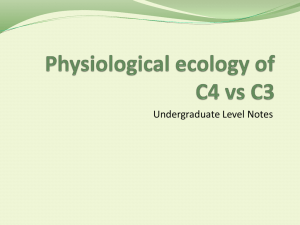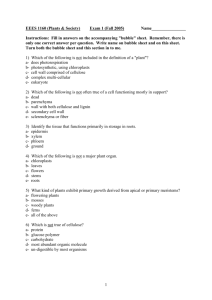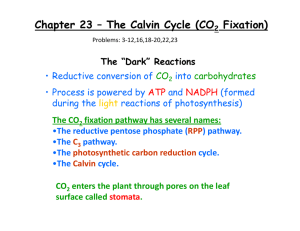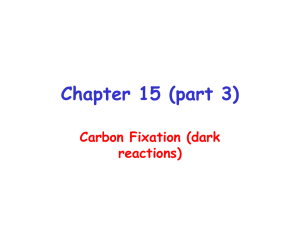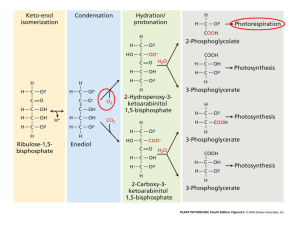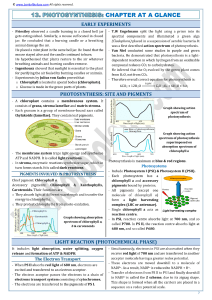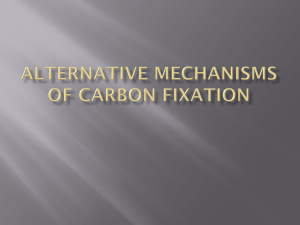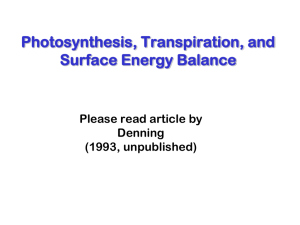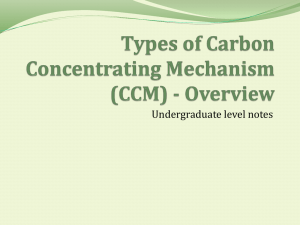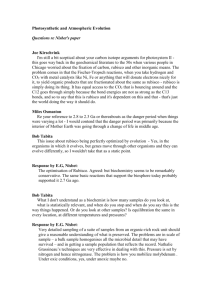Lecture_15_F11
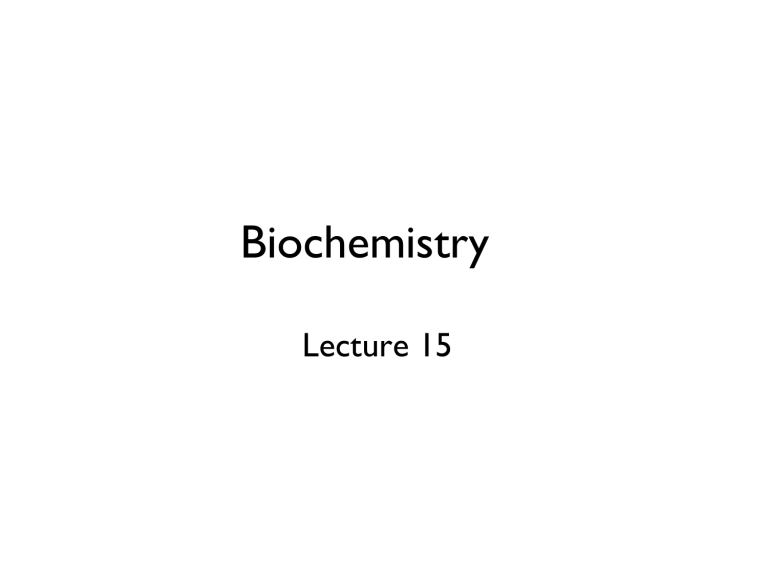
Biochemistry
Lecture 15
Photosynthesis
Chemiosmotic Gradient
Endosymbiotic Theory
Photosynthesis
Assimilation of CO
2 by Plants
CO
2
Assimilation Occurs in
Plastids
• Organelles found in plants and algae
• Enclosed by a double membrane
• Have their own small genome
• The inner membrane is impermeable to ions such as
H + , and to polar and charged molecules
Origin and Differentiation of Plastids
• Plastids were acquired during evolution by early eukaryotes via endosymbiosis of photosynthetic cyanobacteria
• Plastids reproduce asexually via binary fission
• The undifferentiated protoplastids in plants can differentiate into several types, each with a distinct function
– Chloroplasts for photosynthesis
– Amyloplasts for starch storage
– Chromoplasts for pigment storage
– Elaioplasts for lipid storage
– Proteinoplasts for protein storage
Photosynthesis
Review: Light Reactions
Generate ATP and NADPH
The Calvin Cycle
Rubisco (ribulose 1,5 bisphosphate carboxylase / oxygenase )
The Calvin Cycle
Rubisco is Activated via Covalent
Modification of the Active Site Lysine
Fates of G3P
Remaking
R1,5BP
Photorespiration
• So far, we saw that plants oxidize water to O
2 reduce CO
2 to carbohydrates during the photosynthesis and
• Plants also have mitochondria where usual respiration with consumption of O dark
2 occurs in the
• In addition, a wasteful side reaction catalyzed by
Rubisco occurs in mitochondria
• This reaction consumes oxygen and is called photorespiration ; unlike mitochondrial respiration, this process does not yield energy
Oxygenase Activity of Rubisco
• The reactive nucleophile in the Rubisco reaction is the electron-rich enediol form of ribulose 1,5bisphosphate
• The active site meant for CO
2
O
2 also accommodates
• Mg ++ also stabilizes the hydroperoxy anion that forms by electron transfer from the enediol to oxygen
Salvage of 2-Phosphoglycerate
• Complex ATP-consuming process for the recovery of
C
2 fragments from the photorespiration
• Requires oxidation of glycolate with molecular oxygen in peroxisomes, and formation of H
2
O
2
• Involves a loss of a carbon as CO
2 decarboxylation of glycine by mitochondrial
Rubisco in C
3
Plants Cannot
Avoid Oxygen
• Plants that assimilate dissolved CO
2 in the mesophyll of the leaf into three-carbon 3phosphoglycerate are called the C
3 plants
• Our atmosphere contains about 21% of oxygen and
0.038% of carbon dioxide
• The dissolved concentrations in pure water are about 260 M O
2 and 11 M CO
2 equilibrium and room temperature)
(at the
• The K m of Rubisco for oxygen is about 350 M
Separation of CO
2 capture and the Rubisco Reaction in C
4
Plants
• Many tropical plants avoid wasteful photorespiration by a physical separation of CO activity
2 capture and Rubisco
• CO
2 cells is captured into oxaloacetate (C
4
) in mesophyll
• CO
2 is transported to bundle-sheath cells where
Rubisco is located
• The local concentration of CO
2 in bundle-sheath cells is much higher than the concentration of O
2
